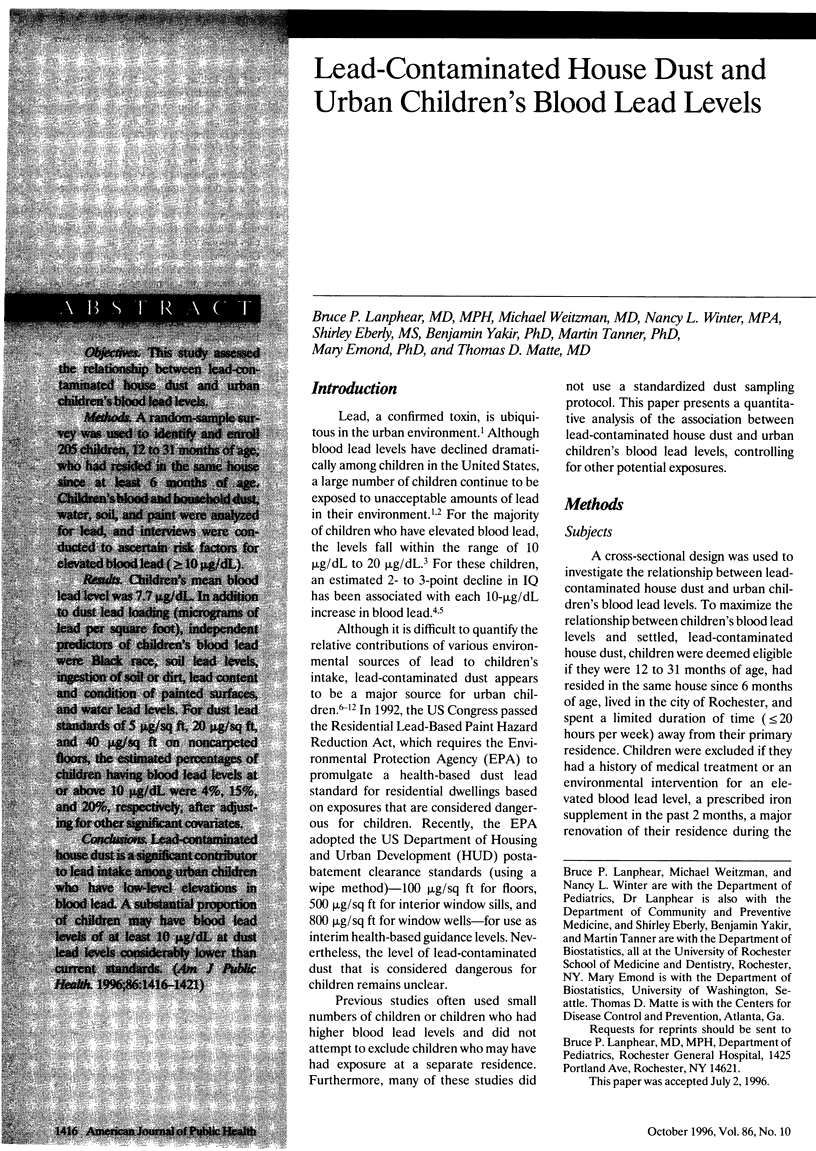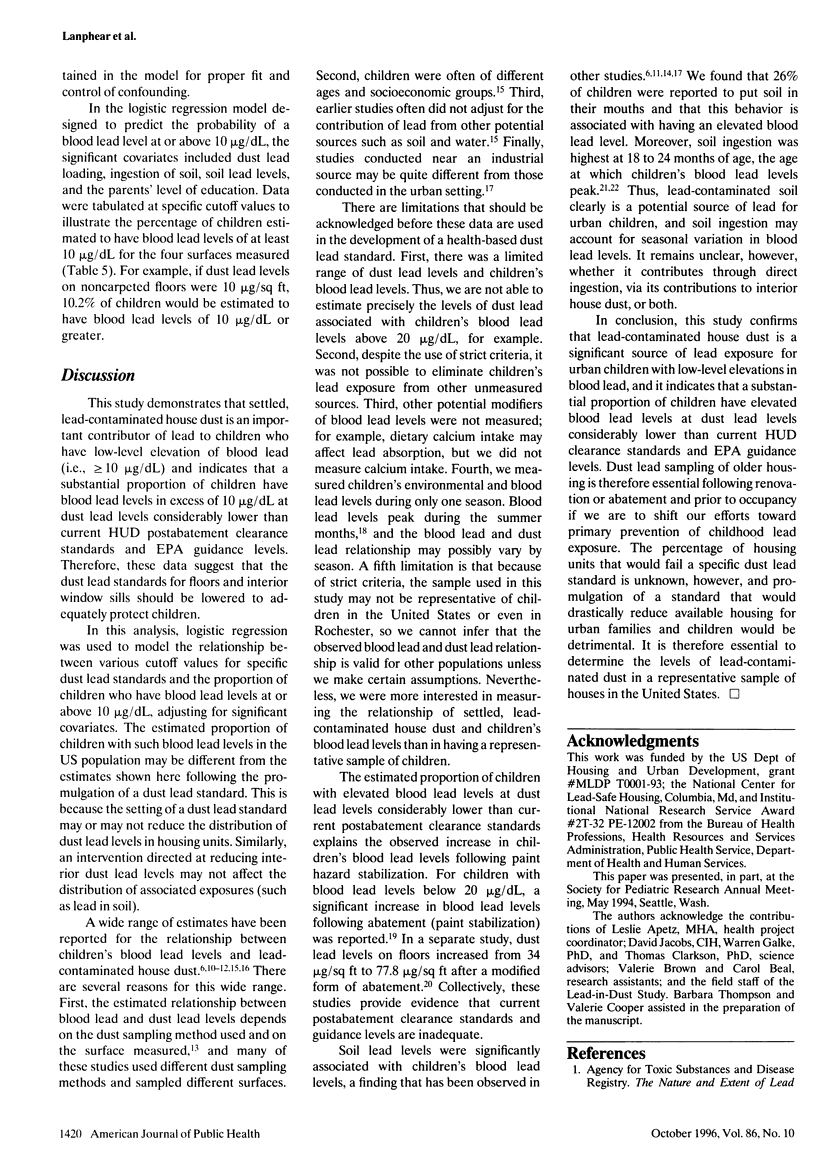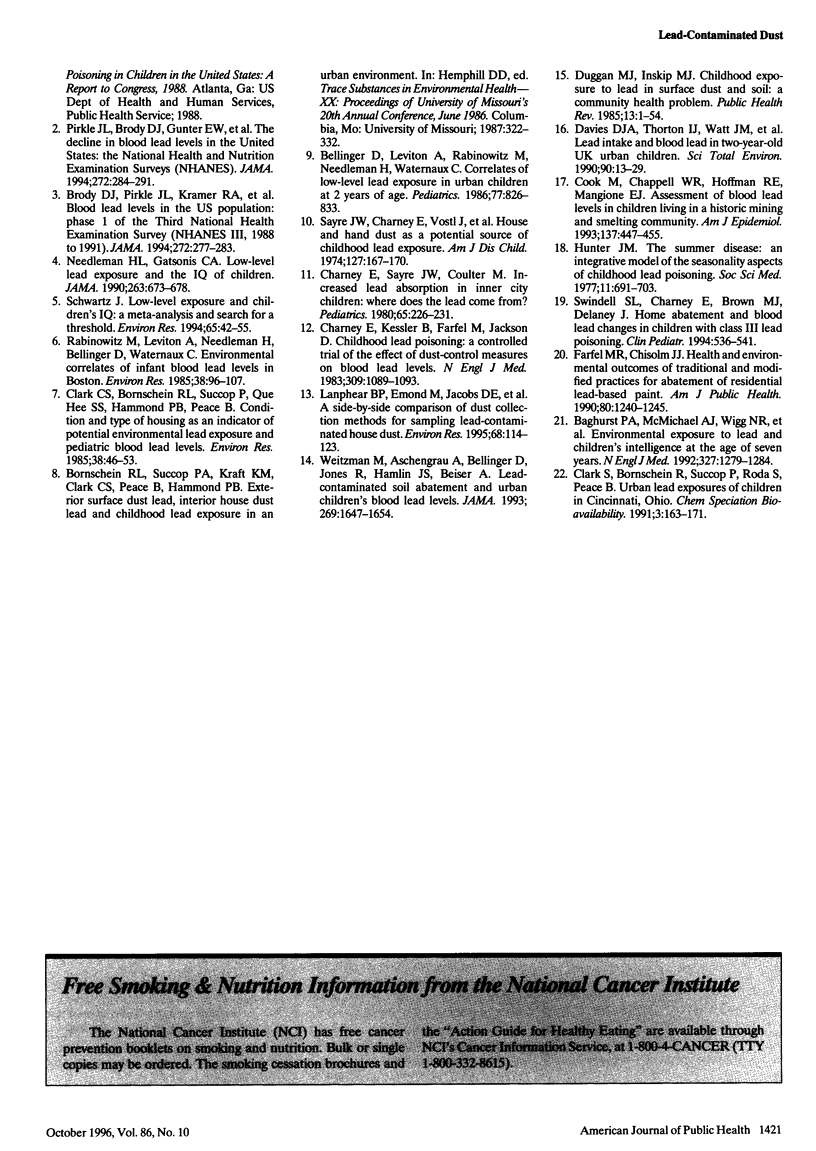Abstract
OBJECTIVES: This study assessed the relationship between lead-contaminated house dust and urban children's blood lead levels. METHODS: A random-sample survey was used to identify and enroll 205 children, 12 to 31 months of age, who had resided in the same house since at least 6 months of age. Children's blood and household dust, water, soil, and paint were analyzed for lead, and interviews were conducted to ascertain risk factors for elevated blood lead (> or = 10 micrograms/dL). RESULTS: Children's mean blood lead level was 7.7 micrograms/dL. In addition to dust lead loading (micrograms of lead per square foot), independent predictors of children's blood lead were Black race, soil lead levels, ingestion of soil or dirt, lead content and condition of painted surfaces, and water lead levels. For dust lead standards of 5 micrograms/sq ft, 20 micrograms/sq ft, and 40 micrograms/sq ft on noncarpeted floors, the estimated percentages of children having blood lead levels at or above 10 micrograms/dL were 4%, 15%, and 20%, respectively, after adjusting for other significant covariates. CONCLUSIONS: Lead-contaminated house dust is a significant contributor to lead intake among urban children who have low-level elevations in blood lead. A substantial proportion of children may have blood lead levels of at least 10 micrograms/dL at dust lead levels considerably lower than current standards.
Full text
PDF





Selected References
These references are in PubMed. This may not be the complete list of references from this article.
- Baghurst P. A., McMichael A. J., Wigg N. R., Vimpani G. V., Robertson E. F., Roberts R. J., Tong S. L. Environmental exposure to lead and children's intelligence at the age of seven years. The Port Pirie Cohort Study. N Engl J Med. 1992 Oct 29;327(18):1279–1284. doi: 10.1056/NEJM199210293271805. [DOI] [PubMed] [Google Scholar]
- Bellinger D., Leviton A., Rabinowitz M., Needleman H., Waternaux C. Correlates of low-level lead exposure in urban children at 2 years of age. Pediatrics. 1986 Jun;77(6):826–833. [PubMed] [Google Scholar]
- Brody D. J., Pirkle J. L., Kramer R. A., Flegal K. M., Matte T. D., Gunter E. W., Paschal D. C. Blood lead levels in the US population. Phase 1 of the Third National Health and Nutrition Examination Survey (NHANES III, 1988 to 1991) JAMA. 1994 Jul 27;272(4):277–283. doi: 10.1001/jama.272.4.277. [DOI] [PubMed] [Google Scholar]
- Charney E., Kessler B., Farfel M., Jackson D. Childhood lead poisoning. A controlled trial of the effect of dust-control measures on blood lead levels. N Engl J Med. 1983 Nov 3;309(18):1089–1093. doi: 10.1056/NEJM198311033091804. [DOI] [PubMed] [Google Scholar]
- Charney E., Sayre J., Coulter M. Increased lead absorption in inner city children: where does the lead come from? Pediatrics. 1980 Feb;65(2):226–231. [PubMed] [Google Scholar]
- Clark C. S., Bornschein R. L., Succop P., Que Hee S. S., Hammond P. B., Peace B. Condition and type of housing as an indicator of potential environmental lead exposure and pediatric blood lead levels. Environ Res. 1985 Oct;38(1):46–53. doi: 10.1016/0013-9351(85)90071-4. [DOI] [PubMed] [Google Scholar]
- Cook M., Chappell W. R., Hoffman R. E., Mangione E. J. Assessment of blood lead levels in children living in a historic mining and smelting community. Am J Epidemiol. 1993 Feb 15;137(4):447–455. doi: 10.1093/oxfordjournals.aje.a116693. [DOI] [PubMed] [Google Scholar]
- Davies D. J., Thornton I., Watt J. M., Culbard E. B., Harvey P. G., Delves H. T., Sherlock J. C., Smart G. A., Thomas J. F., Quinn M. J. Lead intake and blood lead in two-year-old U.K. urban children. Sci Total Environ. 1990 Jan;90:13–29. doi: 10.1016/0048-9697(90)90182-t. [DOI] [PubMed] [Google Scholar]
- Duggan M. J., Inskip M. J. Childhood exposure to lead in surface dust and soil: a community health problem. Public Health Rev. 1985;13(1-2):1–54. [PubMed] [Google Scholar]
- Farfel M. R., Chisolm J. J., Jr Health and environmental outcomes of traditional and modified practices for abatement of residential lead-based paint. Am J Public Health. 1990 Oct;80(10):1240–1245. doi: 10.2105/ajph.80.10.1240. [DOI] [PMC free article] [PubMed] [Google Scholar]
- Hunter J. M. The summer disease. An integrative model of the seasonality aspects of childhood lead poisoning. Soc Sci Med. 1977 Nov;11(14-16):691–703. doi: 10.1016/0037-7856(77)90155-x. [DOI] [PubMed] [Google Scholar]
- Lanphear B. P., Emond M., Jacobs D. E., Weitzman M., Tanner M., Winter N. L., Yakir B., Eberly S. A side-by-side comparison of dust collection methods for sampling lead-contaminated house dust. Environ Res. 1995 Feb;68(2):114–123. doi: 10.1006/enrs.1995.1015. [DOI] [PubMed] [Google Scholar]
- Needleman H. L., Gatsonis C. A. Low-level lead exposure and the IQ of children. A meta-analysis of modern studies. JAMA. 1990 Feb 2;263(5):673–678. [PubMed] [Google Scholar]
- Pirkle J. L., Brody D. J., Gunter E. W., Kramer R. A., Paschal D. C., Flegal K. M., Matte T. D. The decline in blood lead levels in the United States. The National Health and Nutrition Examination Surveys (NHANES) JAMA. 1994 Jul 27;272(4):284–291. [PubMed] [Google Scholar]
- Rabinowitz M., Leviton A., Needleman H., Bellinger D., Waternaux C. Environmental correlates of infant blood lead levels in Boston. Environ Res. 1985 Oct;38(1):96–107. doi: 10.1016/0013-9351(85)90075-1. [DOI] [PubMed] [Google Scholar]
- Sayre J. W., Charney E., Vostal J., Pless I. B. House and hand dust as a potential source of childhood lead exposure. Am J Dis Child. 1974 Feb;127(2):167–170. doi: 10.1001/archpedi.1974.02110210017002. [DOI] [PubMed] [Google Scholar]
- Schwartz J. Low-level lead exposure and children's IQ: a meta-analysis and search for a threshold. Environ Res. 1994 Apr;65(1):42–55. doi: 10.1006/enrs.1994.1020. [DOI] [PubMed] [Google Scholar]
- Swindell S. L., Charney E., Brown M. J., Delaney J. Home abatement and blood lead changes in children with class III lead poisoning. Clin Pediatr (Phila) 1994 Sep;33(9):536–541. doi: 10.1177/000992289403300905. [DOI] [PubMed] [Google Scholar]
- Weitzman M., Aschengrau A., Bellinger D., Jones R., Hamlin J. S., Beiser A. Lead-contaminated soil abatement and urban children's blood lead levels. JAMA. 1993 Apr 7;269(13):1647–1654. [PubMed] [Google Scholar]


